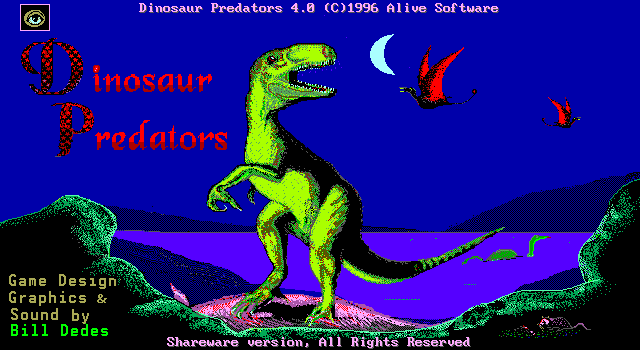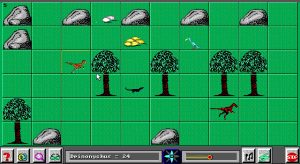Dinosaur Predators 

If you were a child who didn’t like dinosaurs, please raise your hand. Then, stop lying. Every kid who ever existed loved dinosaurs.
The folks at Alive Software probably had a keen sense of this when they made Dinosaur Predators, the second installment in their educational strategy game series. A turn-based strategy game driven by encyclopedic data is a tough sell. But the same game with dinosaurs? Sign me up!
Dinosaur Predators features four different modes, each based on a different geological era. They all play the same: you control a creature that must eat prey, avoid predators, and head back to its home and children over the course of a few screens. Each creature – let’s just say dinosaurs for simplicity’s sake – has a different place in the food chain, and knowing their strengths and weaknesses is half the battle. Stronger dinosaurs listed as “Easy” can tear up whatever they find, while the “Difficult” prey eat plants and can never face off against another dino. Eating food earns points, which eventually unlock the ability to move around the game space diagonally. You can keep playing after getting eaten, but it cuts into your score.
Dinosaur Predators answers to two masters. How good is it as a strategy game? And is it really educational?
The strategy elements bear a little too heavily towards either end of the difficulty spectrum. The mazes that dinosaurs run through are populated with random enemies, and at bottlenecks, that often spells death for some of the weaker guys. Conversely, players who use the Spinosaurus can rampage through the entire game and generally not give a shit. The “Medium” dinosaurs have the most interesting food chains, but there are comparatively few of them. (And unfortunately for all the little kids at heart, the Medium dinosaurs all suck.) Even then, strategy boils down to “eat” or “avoid.” Don’t play this game expecting a deep experience.
The unfair and uninteresting gameplay owes itself to the game’s no-nonsense adherence to fact. From a scientific standpoint, you’ve gotta admire Dinosaur Predators and its commitment to realism. Every piece of flora and fauna you encounter has extensive, in-game encyclopedia article that explains its place in the food chain, taxonomy, and the like. The Jurassic period was not a fun or nuanced time; you either killed or fled. This doesn’t really translate well to a fair or even-handed game, but at least the mass murder is accurate.
Dinosaur Predators admirably tries to turn this accuracy into something educational. But apart from the food chain stuff, that can be mostly avoided. New to the series, the optional Dino-Buff minigame tests your dinosaur knowledge for additional points. This is a godsend on the harder difficulties, as it unlocks diagonal movement early on, but it can be entirely avoided when playing as a more fun dinosaur. I can imagine in a household or school where high scores are competitive, learning about dinosaurs and playing the quiz game could give you an edge. The incentive isn’t enough for anyone playing alone though.
But who cares about education? We all really know that this game is just an excuse to eat hastily drawn dinosaurs. Raauuggh!
(As a note, the shareware version of Dinosaur Predators only contains the Jurassic Dinosaurs mode. The other ones – Terror in the Swamp, Oviraptor Egg-thief, and Ice Age Mammals – are available in the full version, which is still sold online. Presumably, they play the same.)
Trivia!
For some reason, the soundtrack for Dinosaur Predators is composed entirely of classical music MIDIs.



What is the official website to buy this game?
Hi Bryan– Alive Software still has a store for their “legacy games” here: https://alivesoft.com/index.php/legacy-game-downloads/